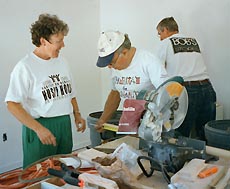|
This is an archived article.
For the latest news, go to the Advance
Homepage
For more archives, go to the Advance Archive/Search Page. |
||
|
Habitat
Husky House a Labor
of Love for Family, Volunteers By Sherry Fisher They dug dirt, hauled lumber, and pounded nails. They poured concrete, put up drywall, and painted ceilings. And when they were finished, they had built a house. Husky House, the first home built by the UConn Chapter of Habitat for Humanity, was the effort of more than 500 volunteers - including students, faculty, staff, and members of the community. Construction on "Husky House," a two-story colonial on Lafayette Street in Willimantic, began in April 2001.
The house, built in partnership with the Windham Chapter of Habitat, will be home to Lillian Rivera, a single mother, and her five children. It was sold to Rivera at cost, with an interest-free mortgage. "It was a great community effort," says Diane Wright, coordinator of community outreach at UConn and a Windham Habitat board member. "There were so many people who got involved in some way - from our facilities people, who did a lot of the electrical and plumbing work, to some administrators who got involved with working with students, to faculty and staff who did some fund raising and building. I think that's a great dynamic." The Habitat project offered students more than just a volunteer experience. "We encourage students to get involved in outreach and community service and this certainly fit the bill in many ways," says Carol Petersen, honorary chairperson of the project. "The Habitat group has learned the project isn't just about volunteering and working: it's about organization and time. They're learning some very good life skills." As well as sawing and spackling, volunteers got to know the Rivera family. Some of the student volunteers took Rivera's children to campus, where they attended shows at Jorgensen and an athletic event. On a sunny Saturday morning, Rivera and her five-year-old daughter Lileana are in the backyard with shovels in hand. "We're filling in dirt around the house and leveling out the land," Rivera says. The little girl struggles with a large shovel and sticks it into a pile of dirt. "This is a hard job," she says. Rivera worked alongside volunteers on the project. As part of the agreement with Habitat, she was required to put in at least 300 hours of "sweat equity." She has put in far more time than that, she says. But the house was a labor of love. "When you're done, it's yours," Rivera says. "It takes a lot of commitment. If you want it and need it, you'll do it." Rivera says that except for plumbing and electrical work, she had a hand in just about everything: "If something breaks, I'll know how to fix it." Many of the volunteers - some of whom had never used tools before - say they acquired new skills. Others felt a renewed sense of community spirit. Julia Mangione, a junior at UConn, surprised herself with what she was able to accomplish. "You exceed your comfort level for a higher cause," she says. "You're up on a ladder, 40 feet in the air and the ladder is shaking and you're scared, but you just do it because it has to be done." Closer to the ground, Mangione is in charge of publicity for UConn's Habitat chapter. George Askew, busy with a circular saw, doesn't seem to mind its loud whir. He turns off the machine to chat: "All the kids were excited, full of energy and willing to work real hard," says Askew, the president of Windham Habitat. Nearby, Ken Cordner - a teacher and Mansfield resident who calls himself a "Habitat regular" - measures a wall. Jonathan Gandhi, a junior at E.O. Smith High School, is outside setting nails in front of the house. Wright and Rivera sand moldings around the dining room door. UConn students raised much of the $50,000 for building costs through fundraisers; faculty and staff donated $10,000 through the Connecticut State Employees Charitable Campaign; and Home Depot donated $12,000 worth of supplies. About 30 local businesses contributed to the effort. Monthly payments from the homeowner will help replenish Habitat's bank account, which will be used to build another home. Although there were more than enough volunteers, last summer the project came to a halt when funding ran out. Petersen stepped in to lend a hand. "When I saw they were stumbling, we just got in the car and knocked on doors," she says. "We helped finish up the funding needs that way." Lileana Rivera runs up the stairs to show off her new bedroom. She races over to a large closet. "I'm going to put everything beautiful in here," she says. Elspeth Poile, a sophomore and co-president of UConn's chapter of Habitat for Humanity, recalls her feelings on the day the of the house's dedication ceremony earlier this spring: "I looked up at the house and realized that we had finished it," she says. "It was a huge sense of accomplishment." |

